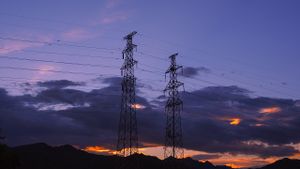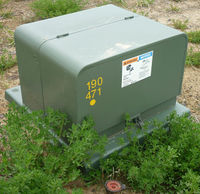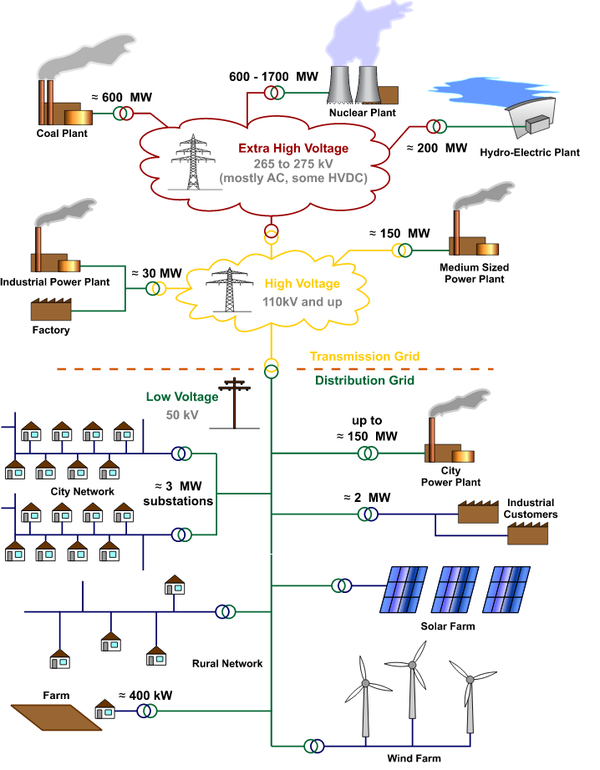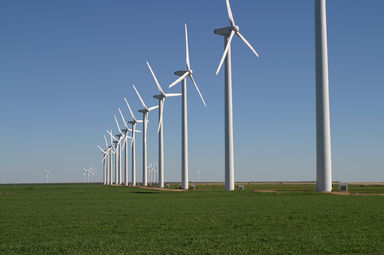Electrical grid: Difference between revisions
m (1 revision imported) |
m (1 revision imported) |
||
| (5 intermediate revisions by 3 users not shown) | |||
| Line 1: | Line 1: | ||
[[Category:Done | [[Category:Done 2021-10-29]] | ||
[[Category:Translated to Spanish]] | |||
[[es:Red eléctrica]] | |||
[[Category:Translated to French]] | |||
[[fr:Réseau électrique]] | |||
<onlyinclude>The '''electrical grid''' is the intricate system designed to provide [[electricity]] all the way from its [[electrical generation|generation]] to the customers that use it for their daily needs. These systems have grown from small local designs, to stretching thousands of [[kilometer]]s and connecting millions of homes and businesses today.</onlyinclude> | <onlyinclude>The '''electrical grid''' is the intricate system designed to provide [[electricity]] all the way from its [[electrical generation|generation]] to the customers that use it for their daily needs. These systems have grown from small local designs, to stretching thousands of [[kilometer]]s and connecting millions of homes and businesses today.</onlyinclude> | ||
| Line 6: | Line 10: | ||
===Generation=== | ===Generation=== | ||
:''[[electrical generation|main article]]'' | :''[[electrical generation|main article]]'' | ||
Electricity begins in '''[[power plant]]s''' which work to convert [[mechanical energy]] of a [[turbine]] into [[electrical energy]] by the use of a [[generator]] (with the exception of [[solar power]], which uses [[photovoltaic cell]]s to accomplish this).<ref name=wolf>R. Wolfson, "Electricity" in ''Energy, Environment, and Climate'', 2nd ed., New York, NY: W.W. Norton & Company, 2012, ch. 11, sec. 1, pp. 292-307</ref> Power plants require the [[energy]] from [[fuel]]s such as [[coal]] or [[natural gas]], or [[flow]]s, such as [[wind]] and [[sunlight]] in order to do this. These plants generate lots of electricity and are often far away from the demand for electricity; the next system (transmission) solves this problem. | Electricity begins in '''[[power plant]]s''' which work to convert [[mechanical energy]] of a [[turbine]] into [[electrical energy]] by the use of a [[generator]] (with the exception of [[solar power]], which uses [[photovoltaic cell]]s to accomplish this).<ref name=wolf>R. Wolfson, "Electricity" in ''Energy, Environment, and Climate'', 2nd ed., New York, NY: W.W. Norton & Company, 2012, ch. 11, sec. 1, pp. 292-307</ref> Power plants require the [[energy]] from [[fuel]]s such as [[coal]] or [[natural gas]], or [[primary energy flow]]s, such as [[wind]] and [[sunlight]] in order to do this. These plants generate lots of electricity and are often far away from the demand for electricity; the next system (transmission) solves this problem. | ||
<gallery mode=packed heights=170px> | <gallery mode=packed heights=170px> | ||
| Line 15: | Line 19: | ||
===Transmission=== | ===Transmission=== | ||
[[File:electrical-863402_1280.jpg|300px|thumb|Figure 1. Large high voltage power lines are a crucial component to the grid as they transport electricity with little energy losses.<ref>Pixabay [Online], Available: https://pixabay.com/en/electrical-wires-grid-power-863402/</ref>]] | |||
:''[[electrical transmission|main article]]'' | :''[[electrical transmission|main article]]'' | ||
[[Electrical transmission]] is accomplished by the use of '''power lines'''. Electricity exiting the power plant passes through a transmission station where the electricity is "stepped-up". This means that the voltage is increased, with a proportional decrease in the [[electric current]] (the amount of [[electron]]s that are flowing per second). This increase in voltage is accomplished by a [[transformer]]. This electricity can flow long distances, with a typical maximum distance being around 500 kilometers.<ref name=hsw>Brain, Marshall, and Dave Roos. (August 4, 2015). ''How Power Grids Work'' [Online], Available: http://science.howstuffworks.com/environmental/energy/power.htm</ref> | [[Electrical transmission]] is accomplished by the use of '''power lines'''. Electricity exiting the power plant passes through a transmission station where the electricity is "stepped-up". This means that the voltage is increased, with a proportional decrease in the [[electric current]] (the amount of [[electron]]s that are flowing per second). This increase in voltage is accomplished by a [[transformer]]. This electricity can flow long distances, with a typical maximum distance being around 500 kilometers.<ref name=hsw>Brain, Marshall, and Dave Roos. (August 4, 2015). ''How Power Grids Work'' [Online], Available: http://science.howstuffworks.com/environmental/energy/power.htm</ref> | ||
| Line 22: | Line 27: | ||
===Distribution=== | ===Distribution=== | ||
[[File:4624935949_5d81aacfbe_z.jpg|200px|thumb|Figure 2. Pad mounted transformer for electrical distribution.<ref>sdpitbull via Flickr [Online], Available: https://www.flickr.com/photos/stevestr/4624935949</ref>]] | |||
:''[[distribution grid|main article]]'' | :''[[distribution grid|main article]]'' | ||
The distribution of electricity first begins with distribution [[substation]]s that use "step-down" transformers, which perform the opposite task of the "step-up" transformer. The voltages of long distance transmission are unsafe for people to handle, so these step-down transformers bring the voltage down to safer levels. The [[distribution grid]] then connects these substations to the customers that require electricity, ranging from large industrial buildings to small homes. More substations and smaller transformers (such as the green boxes seen in Figure 2) help to further lower the voltages, and divide the electricity among subdivisions.<Ref name=hsw/> | The distribution of electricity first begins with distribution [[substation]]s that use "step-down" transformers, which perform the opposite task of the "step-up" transformer. The voltages of long distance transmission are unsafe for people to handle, so these step-down transformers bring the voltage down to safer levels. The [[distribution grid]] then connects these substations to the customers that require electricity, ranging from large industrial buildings to small homes. More substations and smaller transformers (such as the green boxes seen in Figure 2) help to further lower the voltages, and divide the electricity among subdivisions.<Ref name=hsw/> | ||
Latest revision as of 19:47, 20 December 2021
The electrical grid is the intricate system designed to provide electricity all the way from its generation to the customers that use it for their daily needs. These systems have grown from small local designs, to stretching thousands of kilometers and connecting millions of homes and businesses today.
The grid consists of countless complex interconnections, however there are three main sections—electricity generation, transmission and distribution.
Generation
Electricity begins in power plants which work to convert mechanical energy of a turbine into electrical energy by the use of a generator (with the exception of solar power, which uses photovoltaic cells to accomplish this).[1] Power plants require the energy from fuels such as coal or natural gas, or primary energy flows, such as wind and sunlight in order to do this. These plants generate lots of electricity and are often far away from the demand for electricity; the next system (transmission) solves this problem.
Wind power farm.[4]
Transmission

Electrical transmission is accomplished by the use of power lines. Electricity exiting the power plant passes through a transmission station where the electricity is "stepped-up". This means that the voltage is increased, with a proportional decrease in the electric current (the amount of electrons that are flowing per second). This increase in voltage is accomplished by a transformer. This electricity can flow long distances, with a typical maximum distance being around 500 kilometers.[6]
The reason that step-up transformers are used is because when travelling long distances through a conducting wire, electricity will inevitably lose energy to resistance. This problem is essentially solved (not completely, but to an acceptable level) by the use of high voltage power lines. The corresponding power loss in the lines decreases by the square of the current, meaning that if the current dropped by a factor of 2, the power loss drops by a factor of 4.[1]
Distribution

The distribution of electricity first begins with distribution substations that use "step-down" transformers, which perform the opposite task of the "step-up" transformer. The voltages of long distance transmission are unsafe for people to handle, so these step-down transformers bring the voltage down to safer levels. The distribution grid then connects these substations to the customers that require electricity, ranging from large industrial buildings to small homes. More substations and smaller transformers (such as the green boxes seen in Figure 2) help to further lower the voltages, and divide the electricity among subdivisions.[6]
Basic grid setup
The image below shows a simple grid setup. In reality there are many more of each system connected to the grid, however, for a conceptual grasp this image should demonstrate how interconnected even a simple grid may be.

For Further Reading
For further information please see the related pages below:
- Direct current
- Electrical generation
- Electrical transmission
- Distribution grid
- Transformer
- Connecting homes to the electrical grid
- Energy for electricity by country
- Or explore a random page!
References
- ↑ 1.0 1.1 R. Wolfson, "Electricity" in Energy, Environment, and Climate, 2nd ed., New York, NY: W.W. Norton & Company, 2012, ch. 11, sec. 1, pp. 292-307
- ↑ Wikimedia Commons [Online], Available: http://upload.wikimedia.org/wikipedia/commons/b/bb/Gundremmingen_Nuclear_Power_Plant.jpg
- ↑ Wikimedia Commons [Online], Available: https://upload.wikimedia.org/wikipedia/commons/4/4d/Fermi_NPP.jpg
- ↑ Wikimedia Commons [Online], Available: https://upload.wikimedia.org/wikipedia/commons/8/8b/GreenMountainWindFarm_Fluvanna_2004.jpg
- ↑ Pixabay [Online], Available: https://pixabay.com/en/electrical-wires-grid-power-863402/
- ↑ 6.0 6.1 Brain, Marshall, and Dave Roos. (August 4, 2015). How Power Grids Work [Online], Available: http://science.howstuffworks.com/environmental/energy/power.htm
- ↑ sdpitbull via Flickr [Online], Available: https://www.flickr.com/photos/stevestr/4624935949
- ↑ Wikimedia Commons [Online], Available: https://commons.wikimedia.org/wiki/File:Electricity_Grid_Schematic_English.svg




